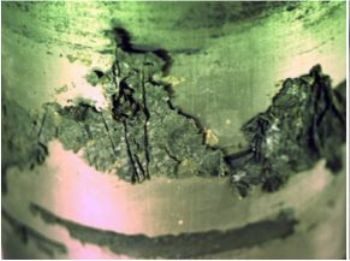Jul 26 2016
Testing liquid metals as target material bombarded by high-energy particles
 Sampling of Lead-Bismuth-eutectic material/cover gas-interface sample consisting of solid material forming a powdery crust onto the steel wall.(Credit: SciencePOD)
Sampling of Lead-Bismuth-eutectic material/cover gas-interface sample consisting of solid material forming a powdery crust onto the steel wall.(Credit: SciencePOD)
There is a growing interest in the scientific community in a type of high-power neutron source that is created via a process referred to as spallation. This process involves accelerating high-energy protons towards a liquid metal target made of material with a heavy nucleus. The issue here is that scientists do not always understand the mechanism of residue nuclei production, which can only be identified using spectrometry methods to detect their radioactive emissions. In a new study examining the radionuclide content of Lead-Bismuth-eutectic (LBE) targets, scientists at the Paul Scherrer Institute Villigen (PSI) found that some of the radionuclides do not necessarily remain dissolved in the irradiated targets. Instead, they can be depleted in the bulk LBE material and accumulate on the target's internal surfaces. These findings have recently been published in EPJ Plus by Bernadette Hammer-Rotzler affiliated with the PSI and the University of Bern, Switzerland, and colleagues from Switzerland, France and Sweden. The results improve our understanding of nuclear data related to the radionuclides stemming from high-power targets in spallation neutron sources. They contribute to improving the risk assessment of future high-power spallation neutron beam facilities --including, among others, the risk of erroneous evaluation of radiation dose rates.
In this study, the authors examine the radionuclide content and the spatial distribution of selected radioactive isotopes produced in two Lead-Bismuth-eutectic targets. The first is called the ISOLDE target and was irradiated with 1-1.4 GeV protons at the eponymous Radioactive Beam Facility at the Particle Physics laboratory CERN, Switzerland. The second, called the MAGPIE target, was irradiated at the PSI with 590 MeV protons.
The team relied on gamma-spectrometry for radionuclide measurement. For radionuclides which cannot be measured directly in the initial samples, the authors developed radiochemical separation procedures. The team explains how these radionuclides —- due to their specific chemical properties —- accumulate in enrichment zones located on the walls of structure components or the interface between the liquid metal and the cover gas. They found that the chemical elements of the lanthanide group –including Gadolimuim 148, Lutetium 173 and Prometium 146—show pronounced accumulation.